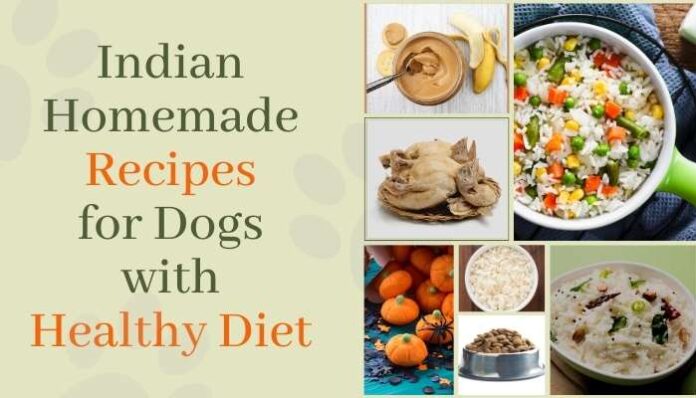Indian Homemade Veg & Non Veg Recipes For Dogs With Healthy Diet Plan
While Indian Pet owners now have access to and happily indulge their pets in commercial pet food brands like Royal Canin, Pedigree and the likes, which provide wholesome balanced meals for their pets, it is almost impossible for them to resist the urge of sharing a few morsels of their meals with their furry friends.
Though these actions are purely out of love, Indian cuisine comes with a lot of ingredients and spices that cannot be categorized as pet friendly. However, the good news is that some of the dishes that are staples in Indian households can be a source of proteins, fats, carbohydrates, vitamins & minerals for our beloved furry friends.
One of the main struggles for millennials is the ongoing confusion of what exactly to feed your dog. Over the centuries in Indian households, we’re seen pet parents feeding dogs basically the leftovers of milk and chapatti. Indian kitchens have restricted food options for dogs, and pet parents often forget the importance of the nutritional requirements of young puppies or dogs. In the growing years, dogs must be provided with an adequate amount of nutritional food as it helps them to achieve a healthy lifestyle. In this blog, we have talked about some delicious Indian homemade recipes for dogs that pet parents can easily make at home. Pet parents don’t need to worry about these recipes as these recipes are vet-approved. Yet every dog has a different physical structure so It would be good to ask their vet before they try these recipes.
In recent years, Indian pet parents have become more conscious than ever and look out for healthy options for pets. Packed or dry food in the market can be expensive, so switching to healthy homemade food can be a great choice. Also, it breaks the boring monotony of having the same food can be full of boredom. We’ve tried to compile a list of Indian recipes for your dogs that they might enjoy trying out
And these dishes are easy to prepare as all the ingredients are available in an Indian kitchen. Not only easy to prepare, but homemade food is very economical compared to packed food. You can follow up with all the recipes mentioned below with utmost trust. We’ve added a vet-approved recipe list for dogs.
Keeping a dog is easy because they demand very little. But what should they be fed? Too many people err and then pay thousands of rupees when the dog falls ill. Kidney and liver failure, malnourishment, obesity, tooth decay, allergic reactions are some of the problems that arise from an inadequate diet. The dog needs a healthy meal, not scraps from the family dinner. Give food with ingredients that are balanced with the correct levels of proteins, carbohydrates and a little fat- remember to vary the ingredients. Most dogs need to be fed twice or thrice a day (puppies need more frequent smaller meals).
Vitamins and minerals are essential to your dog’s health. Vegetables, such as carrots, potatoes, peas, zucchini, etc. are rich source of vitamins. A combination of any of these : Carrots, green leafy vegetables, egg yolks, soyabeans, wheatgerm, cauliflower, pumpkin, tori, parwal, yeast,cheese,legumes, melon,beans, rye ,whole wheat, potatoes, molasses (Jaggery ), cottage cheese,wheat bran,whole grains, bananas, yogurt,sweet potatoes,squash, tomatoes should give you all the vitamins and minerals your dog needs – Calcium, magnesium, potassium, sodium and phosphorus .
Protein is found in dal, eggwhites and dairy. Split yellow lentils and split red lentils are the most digestible
Fatty acids regulate the immune system and are anti-inflammatory. Most important fatty acids are omega 3 and 6. Omega 3 is found in flaxseed oil. Omega 6 can be found in sunflower oil, but ½ a teaspoon is more than enough oil for your dog’s daily intake.
50% of the diet should include carbohydrates in some form- corn, sweet potato, brown rice, oats or soy beans and any form of whole wheat. Not all grains suit all dogs; some can be an irritant, but the only way to find out is to try them in small quantities. The least irritant grain is barley, particularly used for upset stomachs. Dogs like it.
Dogs can eat herbs and seeds, and some of the common ones are : Parsley, mint, basil, rosemary, celery seeds , dhaniya, sunflower seeds, sesame seeds. Do not give garlic or onions.
Genetic Analysis
In 2013, a group of researchers evaluated by comparing the dog’s genetic information (all the genes in the DNA) to that of the wolf and discovered that the differences between the two were mostly due to genes responsible for behaviour traits (i.e., how they went from wolf temperament to golden retriever temperament) and starch digestion. Dogs have evolved to be better at digesting starches (carbohydrates) than wolves, which is one of the fundamental genetic differences between the two species. This is why they are able to digest and thrive on vegetarian food for dogs.
Omnivore vs. Carnivore
In terms of the carnivore vs. omnivore debate, dogs are classified as carnivores, but the Order Carnivora also includes omnivores like bears, raccoons, and skunks, as well as strict herbivores like the giant panda. Dogs, unlike real carnivores like cats and ferrets, lack most of the metabolic adaptations to a rigorous diet of animal flesh. Dogs manufacture more starch-digesting enzymes than real carnivores, have lower protein and amino acid requirements, and can easily use vitamin A and D from plant sources, just like humans. According to the evidence, they may have evolved from wolves by eating more veggie food for dogs. They are better classified as omnivores than carnivores because of all of these traits.
How Switching to a Vegan Diet Would Affect the Pancreas
The pancreas produces digestive enzymes that dogs require to digest their food, among other things. The pancreases of most dogs are excellent at this task, and dogs are excellent at breaking down starch from vegetarian food for puppies. Most plants that are often found in human diets have a high digestibility in dogs, which is similar to what it is in people. There is no indication that consuming a high-carbohydrate diet harms the pancreas.
The second claim is that a carnivore’s pancreas does not secrete the enzyme cellulase to break down cellulose (a type of fibre found in plant cell walls), which is incorrect for two reasons:
- Dogs are more omnivores than carnivores
- No mammal, carnivore, herbivore, or omnivore, makes the enzyme cellulase.
This is why cellulose-rich plants like hay are indigestible to humans and dogs. Fruits, vegetables, and grains do not contain enough cellulose to cause digestive problems in dogs. They need to follow a healthy diet for dogs.
Animals that consume leaves and hay, such as horses, goats, cows, and the giant panda, have bacteria and other microscopic critters in their intestines that have the enzyme, and these little “friends” are the ones who break down the cellulose in the animal’s diet, releasing nutrients.
To put the preceding information into context, humans and chimps share approximately 96–99 percent of their DNA (the entire genome, not just mitochondrial DNA). Yes, dogs are descended from wolves, but it doesn’t mean they have the same dietary requirements as wolves.
How does a vegan diet for dogs work?
Most dogs can thrive on a vegetarian food that covers all of their nutritional requirements. Veterinary nutritionists frequently use meat-free diets to assist in managing a variety of health issues. It’s not easy to come up with these diet plans. While there are a variety of commercial vegan and vegetarian meals available for dogs, not all of them are of equal quality. In general, diets that contain eggs or dairy as a source of protein are less concerning than diets that rely solely on plant proteins. Home-prepared meals invariably perform worse since the great majority of home-cooked meat-based diets fed to dogs lack key nutrients, and vegetarian food for dogs typically has all of the same inadequacies, plus a few more.
According to Andrew Knight, a veterinary professor at the University of Winchester, his research found that cats and dogs on plant-based diets had the same, if not better, health results as those on meat-based pet meals, providing the latter were carefully designed with added synthetic nutrients.
Benefits of Vegetarian Diet for Dogs
Allergy: As per scientists at Tufts University’s Cummings Vet Medical Clinic, “chicken, beef, dairy, and eggs are the most commonly reported food allergies in dogs.” Many dog owners are surprised to learn that grains are a rare cause of food allergies in pets; most are allergic to animal proteins. Rashes, dry and itchy skin, loose stool, constipation, gas, vomiting, eye discharge, yeast infections, and fur loss are all indications of food allergies in dogs. Long-term exposure to allergens is harmful to one’s health since it weakens the immune system. Vegetarian food for puppies is inherently hypoallergenic, so your dog can finally get some respite from his or her annoying symptoms.
Easily Digestible: Vegetarian food for dogs is frequently used to aid dogs with a variety of digestive disorders, including loose stools, constipation, and gas. Meat-based dog foods, on the other hand, can be difficult for the digestive system due to the acidifying and inflammatory properties of animal protein. Plant-based components are gentle on digestion and frequently free of irritating allergens, so they can help even the most sensitive dogs get rid of symptoms.
Anti-inflammatory: Vegetarian food for dogs is naturally anti-inflammatory, which means it can help reduce joint pain and arthritis when compared to animal-based diets (making them an excellent fit for senior dogs). When dogs eat a vegan diet, their mobility improves, resulting in stronger muscles, longer walks, and more stamina at the dog park.
Improves Energy Levels: Because of the clean, readily available nourishment, switching your dog to a vegan diet can help them regain puppy-like vigour (without the negative effects of meat-based and byproduct-heavy food). Vegetarian food for puppies generally results in an abundance of energy as a result of their new diets, contributing to a higher quality of life.
Helps Manage Weight: Vegetarian dog food has a plethora of health benefits, making it an excellent choice for dogs of all shapes, sizes, and ages.It’s time to try a nutritionally complete vegan diet if your dog has persistent symptoms like itchy skin, digestive difficulties, joint pain, or eye discharge. When you switch your dog to a plant-based diet, you may expect five wonderful health benefits.
Can The Combination Of Roti/Chapati & Milk Be Constituted As A Meal For Your Pet?
Providing roti & milk is almost an age-old tradition in Indian culture. Be it feeding strays or feeding our pets, at some point in their lives, we have provided them with a bowl of roti dunked in milk. However, based on a survey conducted by the department of livestock products technology at Guru Angad Dev Veterinary and Animal Sciences University (GADVASU), it was found that a diet consisting only of roti & milk is insufficient for the overall development of your dog’s health. Therefore, it is essential to include fruits, vegetables & meat in your pooch’s diet plan and not rely only on the humble roti/chapati & milk for all the nutritional needs of your pet. Please note that milk should not be given to puppies below 6 months of age and for adult dogs, it should be diluted with a little water.
How Important Is It To Include Eggs & Meat In Your Pet’s Diet?
Animal protein should be a primary component in your pet’s meal plans. Protein sourced from eggs & meat is highly beneficial for your dog’s health. Meats like Fish, Chicken, and Mutton are common in a few households; however, it is crucial to ensure the meat is uncooked and does not have any seasoning or spices. Cooked bones are not recommended as they are brittle and have the potential of causing oral injuries and can also cause obstructions in intestines, which could need surgery.
When it comes to Eggs, it is recommended to either boil or scramble the eggs without adding any condiments as raw eggs contain an enzyme called ‘avidin’ that is known to decrease the absorption of vitamin B and may cause problems with the coat and skin.
For vegetarian households, introducing meat/egg into their pet’s meals can be tricky, however, is crucial for the pet’s wellbeing. That is when the combination of home-cooked meals, grains, vegetables, fruits & commercial dog food brands comes to the rescue.
Role Of Grains & Pulses
Contrary to popular belief, grains do not harm your pets and instead are a rich source of vitamin B-complex, fibre, and iron. Therefore, when pet owners fall for the deceiving hype around grain-free diets for their pets, they end up robbing off essential nutrients that contribute to their dog’s health, growth, and functioning of bodily enzymes. A mix of brown rice and boiled mashed vegetables constitutes for a healthy, light meal for your pet. Like some of us humans, a few dogs can be allergic to gluten, however, for the majority of dog population whole grains like brown rice, wheat, oats, barley, millet, and quinoa are healthy & nutritious. You can also test small portions of soya bean to see if your pooch acquires a liking to it.
Optimal Utilization Of Vegetables
Vegetables are a powerhouse of essential nutrients and can be included in your pet’s meals to provide variety in terms of taste, texture, and colour. Vegetables like potatoes (avoid using green areas that develop on potatoes), sweet potatoes, green beans, pumpkin, bottle gourd, and peas should be boiled and mashed, especially, if they are in larger quantities.
Fresh & texturally crunchy vegetables like cucumber, carrot, broccoli, and spinach can also be included in your pet’s diet, which can provide the necessary relief and variation from regular food for your pooches. These can be served fresh or boiled.
Tomatoes (need to be ripe) can also be included in your pet’s diet; however, extra care needs to be taken to ensure that your dog does not consume leaves or stems of tomatoes as they can do more harm than good.
Vegetables that should NOT be included in your dogs’ diet are Onion & Garlic (in any form – raw, cooked, powdered, dried), as these contain a toxic ingredient called thiosulphate, which can cause potentially fatal hemolytic anaemia in canines. Therefore, it is extremely important to resist the urge of feeding your pets our day to day curries/dals.
Including Fruits During Snack Time
A great option to use especially for snacking for both humans and dogs between meals are fruits. However, ensure that you do not feed your dogs with grapes, raisins or currants as they could irreversibly damage their kidneys. When feeding them with apples, ensure that they do not consume seeds as they contain cyanide and are poisonous for dogs.
Other fruits like melons (water & musk, without rinds), berries (raspberries, strawberries, blackberries, blueberries) can be included in your pet’s diet. Serving a bowlful of a variety of fresh seasonal fruits, cut up in bit sizes can help in encouraging your pooches to have these healthy treats.
Dairy Products
Similar to gluten, some pets might be lactose intolerant. However, for the majority, boiled milk/ homogenized carton and pasteurized milk can be provided. Milk is not inherently bad for your adult dog; however, providing milk in moderation and in diluted form is the key.
You can also add small quantities of cottage cheese, curd/buttermilk from time to time for your pets to enjoy.
Apart from the above-mentioned food items, below are other food items that you should NOT feed your dogs:
- Chocolates:Dark chocolate, baking chocolate & cocoa beans contain high levels of theobromine and caffeine, which can cause hyperactivity, restlessness, muscle twitches, increased urination, and excessive panting, if consumed in large quantities. It is best to avoid feeding any kind of chocolate to your pets.
- Coffee/Tea:Like chocolate, coffee & tea also contain caffeine, which can cause diarrhoea, vomiting, and is harmful to the heart and nervous systems of your dog.
- Avocado, Plum, Peaches:Though these fruits are not necessarily included in the list of toxic foods for dogs, they contain a type of cyanide compound that can poison your dog if he eats enough of the stems, seeds, and leaves, which can result in dilated pupils, breathing difficulties, hyperventilation, shock, and apprehensiveness.
- Nutmeg:Nutmeg is a popular spice used when preparing Indian sweets & mithai. Accidentally consuming nutmeg can cause seizures, tremors, central nervous system problems, and even death in some canines.
Like anything else, even the items that are nutritional to your pets like grains, fruits & vegetables, treats, and meats when given in excessive quantities can be harmful. Therefore, it is essential to portion your pets’ meals and check about the frequency of their meals with your vet. Additionally, allergic reactions to particular food items vary from dog to dog, so it is always a good practice to observe your dog each time you feed it a new food item
Dog treats can be biscuits, carrots or apples.
Start the day with a bowl of milk with cornflakes and dog biscuits. Around 2 p.m., you can give your dog plain rice or chappatis with curd ,vegetables and dal. Small pieces of banana, papaya, mango, apple can be given after the meal. Dogs are very happy to munch on pieces of cucumber/ tomato/ radish/ carrot. At night you can give your dog chappatis or rice with soyabeans, dal and a boiled or scrambled egg.
Here are some recipes:
Baked Breakfast
Ingredients:
- 2 Cups Wheat Flour
- ¼ Cup Wheat Germ
- ½ Cup Powdered Milk
- ¼ tsp. Salt
- 6 tbsp. Butter
- 1 egg, Beaten
- 1 tbsp. Molasses(or Jaggery)
- Water (approx. ½ Cup)
Procedure:
- Combine dry ingredients.
- Blend in butter.
- Add egg and molasses, mix thoroughly.
- Add enough water to form a dough ball.
- Roll out ¼ inch thick and cut into shapes. Place on greased cookie sheet.
- Bake 20 min. at 375 degrees.
Doggie Delight
Ingredients:
- 1 Cup Wheat Flour
- ½ Cup Oats
- 1 Cup Carrot, Grated Medium
- 2 tbsp. Peanut Butter
- 4 tbsp. Honey
- ½ Cup Milk
- 1 tbsp. Olive Oil
- 1 tbsp Fresh Mint, finely chopped
Procedure:
- Mix all ingredients in order listed above, mix well with hands until its ready to roll out about ¼ inches thick.
- Use small circle cookie cutter. What dough is left, roll in to marble size and put on lined cookie sheet.
- Heat oven to 325°F put in treats and cook 7-10 min.
- Serve
Wheat Treat
Ingredients:
- 9 Cups Wheat Flour
- 1 Cup Nutritional Yeast (Not Baking Yeast)
- ½ Tbsp. sugar
- Vanilla Extract
Procedure:
- Mix dry ingredients. Add approximately 3 Cups water. Knead into a pliable dough. Roll out to 1/8″ thickness. Cut into desired shapes.
- Bake for 10-15 minutes at 350°F. (Important: After turning off oven, leave biscuits in the oven overnight or for an 8-hour period so they become hard and crunchy.)
Cheesy Heeng Cookies
Ingredients:
- 1½ Cups Flour
- 2 Cups Milk
- 1 Cup Cheese (grated)
- ½ Stick Margarine
- Asafetida ( Heeng)
Procedure:
- Whip the grated cheese and margarine in a bowl for 2-3 min.
- Add the flour and mix thoroughly.
- Pour some milk and knead the mixture into a ball.
- Refrigerate the ball for ½ hr.
- Roll and shape it into as many cookies as possible.
- Bake until cookies are a light golden brown.
Oatmeal Wheat Treats
Ingredients:
1 Cup Oatmeal·
1 Egg, beaten·
1 ½ Cups Hot Water·
¾ Cups Cornmeal·
3 Cups Whole Wheat Flour·
Procedure:
- Preheat oven to 325degree F.
- In a large bowl pour hot water over oatmeal and let stand 5 minutes.
- Stir in cornmeal and egg. Add flour, ½ cup at a time, mixing well after each addition.
- Knead 3 to 4 minutes, adding more flour if necessary to make very stiff dough. Pat or roll dough to ½ inch thickness. Cut into shapes and place on a greased baking sheet.
- Bake for 50 minutes. Allow to cool and dry out until hard.
- Store in an airtight container.
Pumpkin Treats
Ingredients:
½ Cup Mashed Raw Pumpkin·
½ Cup Water·
2 tbsp Sunflower Oil·
1 tsp Ground Cinnamon·
½ Cup Oatmeal·
2 Cups Whole Wheat Flour·
Procedure:
- Preheat oven to 375°F.
- Combine pumpkin, water, oil and cinnamon.
- Add flour and oatmeal slowly, mixing after each addition.
- Roll dough on a floured surface to ¼ inch in thickness. Cut into desired shapes.
- Bake 40 minutes on an ungreased cookie sheet.
Tasty Bones
Ingredients:
- 3 Cups Minced Parsley
- ¼ Cup Carrots, chopped very fine
- 2 tbsp Olive Oil
- 2 ¾ Cups Whole Wheat Flour
- 2 tbsp Bran
- 2 tsp Baking Powder
- ½ to 1 Cup of Water
Procedure:
- Preheat oven to 350°F, rack on middle level. Lightly grease a large baking sheet.
- Stir together parsley, carrots and oil. Combine all the dry ingredients and add to veggies.
- Gradually add ½ Cup of water, mixing well. Make moist but not wet dough. If needed, add a little more water. Knead for one minute.
- Roll dough out to ½ inch thickness. Cut out the shapes and transfer them to the baking sheet. Gather the scraps and reroll and cut.
- Bake for 20-30 minutes until biscuits have browned and hardened slightly. (They will harden more as they cool.) Speed cooling by placing them on wire racks. Store in an airtight tin.
Frozen Yogurt Delights
Ingredients
170gm container of plain, non-fat frozen Yogurt·
1 Cup of no-sugar added Fruit Juice·
½ Cup of carrots, minced·
Procedure:
- Add the yogurt, fruit juice, and carrots into a medium-sized bowl. Stir until the ingredients are smooth and well-blended.
- Drop the mixture into the ice cube trays by spoonful.
- Freeze until the ingredients are solid.
Healthy Smoothie
Ingredients:
1 Apple·
3 Carrots·
1 tsp Turmeric·
1 Cup of Vegetable stock·
1 tbsp of Sunflower seeds·
2 globs of Peanut Butter·
Procedure:
- Blend it all together
Day/Night Meals for Dogs
Potato and Lentils
Ingredients:
1 large Potato·
1 Cup Lentils·
1 Cup mixed, chopped Vegetables , specially pumpkin·
1 Cup organic low-fat Cottage Cheese·
- 3 Tablespoons of Flax Seed Oil (remember to keep this refrigerated!)
Procedure:
- Dice the potato, leaving the skin on and boil in just enough water to cover for 15 – 20 minutes over medium heat.
- Cook the lentils. Put the chopped vegetables as the lentils cook, by adding them to the lentils for the last 10 minutes of cooking time .
After cooking, cool all the ingredients down and mix together with the remaining ingredients (cottage cheese, flax oil ) and serve.
Oat and Soy Meal
Ingredients:
1 Cup Quick Cooking Oats·
¼ Cup Soy flour or Soy milk powder·
¼ Cup Wheat Bran·
1 tbs. Soy Lecithin·
1 tbs. Wheat Germ·
1 tbs. Ground Sunflower Seeds·
1/6 tbs. Molasses·
1 tsp. ground flax seed·
½ tbs. Oil (organic, un-processed oil) optional for healthy dog, not cooked·
Procedure:
- Mix all together and soak in hot water for about 20 minutes and it will be ready to serve.
Note: You can put all ingredients in a small plastic jar or prepare multiple jars at the same time and place all of them in the freezer. Take each jar out when you are ready and add hot water.
King’s Rice:
Ingredients:
- 250 gm Rice (soaked in water but not cooked)
- Soaked Soya Beans
- Two Carrots
- 1 Capsicum
- French Beans (2)
- Turmeric Powder
- Cumin Seeds
- Just a little bit of Oil
Procedure:
- In a pressure cooker, put just a little amount of oil and let it heat.
- Add 1 tsp cumin seeds
- Add freshly cut carrots, capsicum and beans
- ½ – 1 tsp Turmeric Powder and Soya Beans
- Mix the mixture and then add Rice.
- After thoroughly mixing it again, add water ( double the amount of rice)
- If you have added one Cup rice, add 2 Cups water.
- Close the cooker lid and wait for the first whistle to go up ( approx 4 min)
- When the second whistle is half through, take the contents out and serve.
Here are Easy Indian Homemade Non Veg Recipes for Dogs:
Curd Rice Mix
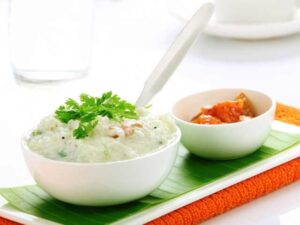
Ingredients:
Rice
Curd
Boiled eggs
Preparation:
Boil rice and cook them when followed by bringing mixing the rice with curd at room temperature. For eggs, boil 2-4 eggs depending on your dog’s physicality, and mix boiled eggs along with the curd rice. This dish is easy to digest contains lots of nutrients and is a tasty meal for your dog.
Interesting Fact: Generally, add a pinch of turmeric which is very good for dogs. Why? The primary active element in turmeric is a substance called curcumin. Dog turmeric provides anti-inflammatory, wound-healing, antiviral, antibacterial, antifungal, antioxidant, and anticancer properties.
Many of the components and spices used in Indian food are toxic to dogs. The good news is that several traditional Indian foods can provide our loving friends with a source of protein, fat, carbohydrates, vitamins, and minerals.
Carrot Rice Mix (Veg)
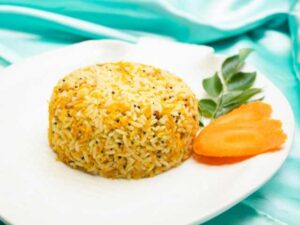
Ingredients:
Rice
Carrot
Potatoes
Preparation:
Boil rice and cook them when followed by bringing mixing the rice with carrots. Carrots must be steamed or you can add fresh and raw carrots too. For potatoes, boil 2-4 potatoes depending on your dog’s physicality, and mix boiled & mashed potatoes along with the carrot rice. This dish is easy to digest contains lots of nutrients and is a tasty meal for your dog.
Boiled Chicken and Rice
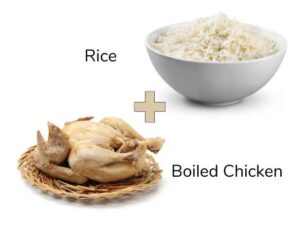
Just as the name suggests, this is one of the easiest and tastiest meals for your dog. If you’re on the go and don’t have time to prepare something for a full-fledged time, then this one will save tons of time for you. All you require for this is:
Ingredients:
Chicken
Rice
Preparation:
You can start by cleaning the chicken well and thoroughly. Once you clean it well, you simply added some water to a pressure cooker and add chicken and give it a boil. There is no need to add salt or any other spices. (As Indian households are prone to adding spices to food). After a few whistles add cooked rice and you’re good to go.
It is also important to address the main question Can I feed chapatti/roti to my dog?
In Indian culture, giving roti and milk to a dog is a custom that almost every household has experienced at some point when raising a dog. We have served roti soaked in milk to animals at some time in their life, whether it was strays or your dogs.
According to recent studies, roti and milk alone are insufficient for your dog’s growth and overall development. Additionally, it is crucial to add fruits, vegetables, and meat to your dog’s diet and not just rely on milk and the modest roti/chapatti.
Note: Make sure that puppies under six months old are not given milk. For adult dogs, dilute the milk with a little water to prevent digestive issues. Yet mostly it is advisable not to feed milk to dogs.
Well-balanced bowl
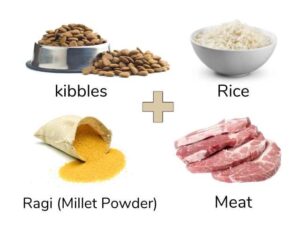
Ingredients:
Dry kibbles
Meat
Rice
Ragi
Preparation:
Soak the kibbles in hot water.
Now the next steps include washing the meat properly and boiling it for the next 15mins. Mix all in a pan and add two tablespoons of Table Millet (Ragi) powder. Let it cool, to make it more digestive you can add some yogurt/curd. To top it all, add eggs to the mixture.
This is a dish your dog will definitely enjoy as it has a mixture of all the flavors. Also, an amalgamation of all important nutrients will help your dog to maintain a healthy gut.
Pumpkin Treats
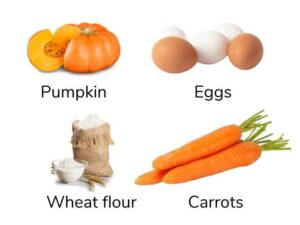
These pumpkin dog treats are healthy and safe for virtually any pup. They’re a great option for dogs with digestive issues and offer a low-calorie snack for pets on a diet. There are about 12 calories in each treat, but you can easily break them into smaller pieces to offer fewer calories per treat.
Ingredients:
Pumpkin
Egg
Carrots
Whole wheat flour
Preparation:
In a large bowl, combine the flour, pumpkin, egg, and carrots. Make little balls out of the batter and lay them on a cookie sheet that has been generously oiled after completely combining.
Place them on the baking tray on top of the sheet and grease the top of the balls. Bake these pumpkin dog treats for about 30-35 minutes in a 350˚ oven. They will turn golden brown and be crispy on the outside when finished baking.
This one is a quick, simple and healthy way of preparing treats for your pup. My pup loves these pumpkin balls!
Banana Peanut Butter Treats
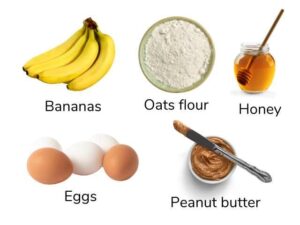
Dogs enjoy bananas as a tasty treat. The salty, processed, and sometimes harmful dog treats we frequently purchase at the grocery store are significantly less nutrient-dense than many fruits and vegetables.
Potassium, vitamin B6, and vitamin C are all abundant in bananas. In fact, this fruit is occasionally suggested by vets as a wholesome substitute for salty, fatty snacks. The fruit is also rich in fiber, which may be helpful if your dog is experiencing digestive issues, and magnesium, which supports bone development and aids in the body’s production of protein and vitamin absorption.
Ingredients:
Bananas (preferably ripped)
Oats flour
Eggs
Honey
Peanut butter
Preparation:
Make a smooth batter of all the ingredients. Mix them well and place these treats on a baking tray on top of a sheet. Put the tray inside a preheated oven for approx. 20 mins and once the cookie treats are ready, voila! Pretty sure your dog would be waiting only by the smell of the treats.
Khichdi
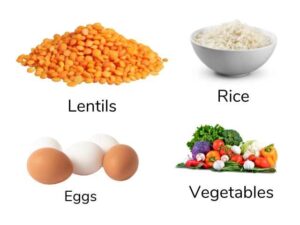
Indian households always cherish fresh and healthy khichdi. It is delicious and provides all the important nutrients. You’d be surprised to know that just as khichdi is a healthy option for us, in the same manner, it is a healthy option for our furry companions too.
The most important factor to keep in mind is to completely avoid spices and oil. For a dog’s diet, healthy khichdi should be spice free. Now let’s quickly dive into the recipe.
Ingredients:
Rice
Lentils
Egg
Vegetables
Preparation:
In a pressure cooker, add water and all the ingredients and whistle 4 to 5 times. Avoid onion, garlic, or tomatoes. Any seed ingredients are not healthy for dogs and must be completely excluded from the diet. You can few chicken pieces as it makes your whole diet much more exciting for your dog.
If your dog has weak digestion, khichdi is a safe option compared to dry-packed meals.
Common Food Options for Indian Homemade Meals for Dog
A responsible pet parent must be aware of all the important dos and don’ts that should be kept while planning a diet plan for your dog. There are now several brands available in India offering a variety of dog dry food. Yet your dog’s ultimate favorite will always remain the food coming out of your kitchen. Dogs love to look at us while we’re enjoying our meal. The reason behind that is they love homemade meals and enjoy having food that is made with love and care.
So when you bring home a new pet make sure to consult a vet and know the nutritional requirement of your pet. The diet of your pet changes with age as the requirements change with age and health. Once you have a thorough knowledge of what to feed your pet it gets much easier to manage the good health of your pet.
Below are some important diet inclusions for your pet dog:
Boiled eggs

Eggs are a fantastic source of nutrition for your dogs and are completely safe for dogs. They benefit your dog both internally and externally because they are rich in protein, fatty acids, vitamins, and fatty acids. Eggs are a fantastic source of nourishment. They are rich in protein, fatty acids, vitamins, and vitamins that nourish your dog both internally and externally.
Consult your veterinarian before giving eggs to your dog. Check first because certain dogs with medical issues shouldn’t consume eggs. Speaking to your veterinarian about the proper amount of eggs to give your cherished dog is a wise decision because eating too many eggs may also result in health issues like obesity.
Vegetables

Vegetables can be beneficial for dogs’ diets. In addition to nutrients and fiber, corn and potatoes provide them with carbohydrates for energy. Dogs may obtain these nutrients without veggies, though.
About one-fourth of a dog’s meals can be made up of vegetables. It can provide nutrients, minerals, and fiber for dogs. Anyway, pureeing veggies rather than slicing them is a better way to incorporate vegetables into your dog’s diet because it will provide them with more nutrition. Squash, pumpkin, zucchini, carrots, peas, beets, sweet potatoes, broccoli, cauliflower, green beans, and sweet potatoes are some examples of vegetables you can include.
Note: You can’t feed your dog every vegetable, and the ones you should really avoid include onion, potato, tomato, ringer peppers, spinach, basic beans, garlic, leek, chard, and beet greens.
Veggies are Highly Recommended for Overweight Dogs
Veterinarians frequently advise adding veggies as filler to the kibble of an overweight dog. With fewer calories, it will increase the satisfaction of their meal. Your veterinarian could advise adding canned pumpkin to your dog’s food for a few days to help with constipation until the problem resolves itself.
Fruits
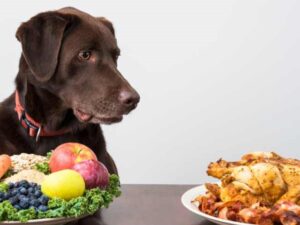
The following organic items are some of the few that are completely safe and even beneficial for your dog, despite the fact that they cannot replace the daily meal. Sugarcane, watermelon, guava, cucumber, mango, pineapple, and banana are all edible to dogs.
Simply avoid citrus or overly fragrant natural items as well as organic citrus products like lemon and orange. You should be liberated. Even though mango mash/skin is fine, care should be made to avoid giving seeds of large organic goods like mango.
Apples are yum yum treat the affair
An apple a day keeps the doctor away – not only for humans but also dogs. For munching instead of giving chocolates or packed chips and snacks to dogs we’d recommend opting for apples. Apples are helpful for a dog’s overall health. Apples are a great addition to your dog’s diet since they provide dietary fiber, vitamin A, and vitamin C. They also give you a technique to maintain the cleanliness of your dog’s teeth and their breath! Before feeding the apple to your dog, make sure the core and seeds have been removed.
Conclusion
Homemade food can be better for dogs because it allows for greater control over the ingredients and the quality of those ingredients. Store-bought dog food can contain fillers, preservatives, and other additives that may not be healthy for dogs. Homemade food also allows for the inclusion of fresh fruits, vegetables, and lean meats that can provide essential nutrients for dogs. Additionally, homemade food can be tailored to meet the specific dietary needs or allergies of an individual dog.
Try slowly switching to homemade Indian dog food recipes for your dog.
Frequently Asked Questions:
- What are the benefits of homemade dog food?
Homemade food can be tailored to meet the specific dietary needs or allergies of an individual dog. It allows greater control over the ingredients and the quality of those ingredients, avoiding fillers, preservatives, and other additives that may not be healthy for dogs. Homemade food can also include fresh fruits, vegetables, and lean meats that can provide essential nutrients for dogs.
- What ingredients should be avoided in homemade dog food?
Ingredients that should be avoided in homemade dog food include onions, garlic, chocolate, grapes, raisins, macadamia nuts, avocado, and xylitol. These ingredients can be toxic to dogs and should be avoided to prevent potential health issues.
- How do I balance the nutrients in homemade dog food?
A balanced homemade diet for dogs should include a source of protein, carbohydrates, and healthy fats, as well as essential vitamins and minerals. It is important to consult with a veterinarian or a professional nutritionist to ensure that the diet is nutritionally balanced and adequate for the dog’s needs.
- Can homemade dog food be stored and reheated?
Yes, homemade dog food can be stored and reheated, but it is important to do so safely. It should be stored in an airtight container in the refrigerator or freezer, and reheated until it reaches a safe temperature (165°F) before serving it to the dog.
- How much homemade dog food should I feed my dog?
The amount of homemade food that should be fed to a dog depends on the dog’s age, weight, and activity level. It is important to consult with a veterinarian or a professional nutritionist to determine the appropriate portion sizes for your dog.
Compiled & Shared by- This paper is a compilation of groupwork provided by the
Team, LITD (Livestock Institute of Training & Development)
Image-Courtesy-Google
Reference-On Request.
HOW TO PREPARE BEST HOME MADE DOG FOOD : PUPPY FEEDING CARE AND MANAGEMENT PRACTICES



